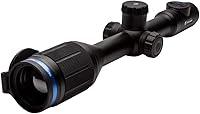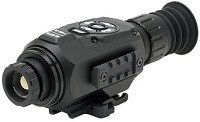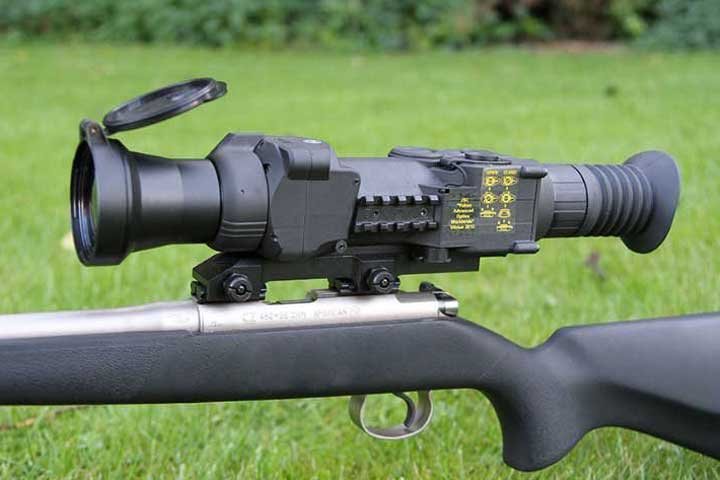
Every object, either man-made or natural will emit heat. Infrared technology can reveal very subtle differences in temperature, and show objects which may normally be invisible to the naked eye.
Thermal scopes are also known as thermal imaging scopes, IR scopes and heat vision. Thermal imaging is a type of technology used to detect heat.
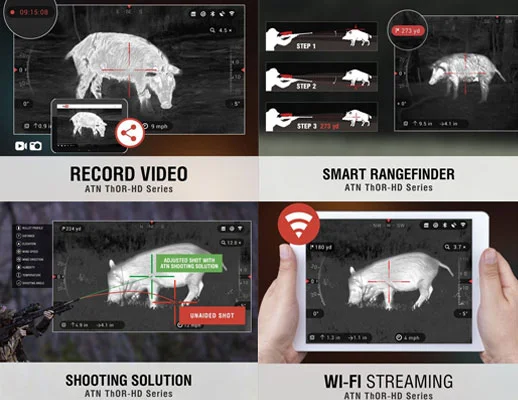
It can be used in many different ways and it’s growing in popularity. Thermal scopes are used by the military and other parties for things like night vision, but they can also be used for hunting.
Thermal scopes are similar to night vision scopes, in that they both use infrared to see at night.
Night vision uses reflected infrared light, while thermal imaging uses emitted infrared light. But thermal cameras can also be used during the day.
Thermal scopes are great for wildlife and security surveillance. They can detect movement that other cameras cannot, and they penetrate darkness that would otherwise prevent you from seeing anything at all.
Heat vision can be used for hunting, observing wildlife, military operations, and even to search for fossils. These infrared technologies use the different temperatures of objects in the area to generate an image on a monitor or display.
Thermal scopes can show objects even in adverse weather conditions. There are many thermal scopes available and sometimes it can be hard to decide which one is suitable for you.
How Thermal Scopes works
Thermal scopes collect the heat from objects and display the heat on a screen. The heat is displayed with colors, which can change depending on the temperature.
Heat is a radiance that is emitted by most objects and can be measured using thermal sensors. Thermal scopes collect the emitted heat and display it on a screen. The heat is displayed with a spectrum of colors, which change depending on the temperature of the object they are detecting.
Thermal imaging uses infrared technology to see objects in detail that are not visible to the naked eye.
The thermal scope is used by the military to detect enemies at night. It can also be used to find animals or other objects that are warm in the night.
Thermal Scope vs. Night Vision Scope
Night vision scopes are similar to thermal scopes in the way that they collect heat and display it on a screen.
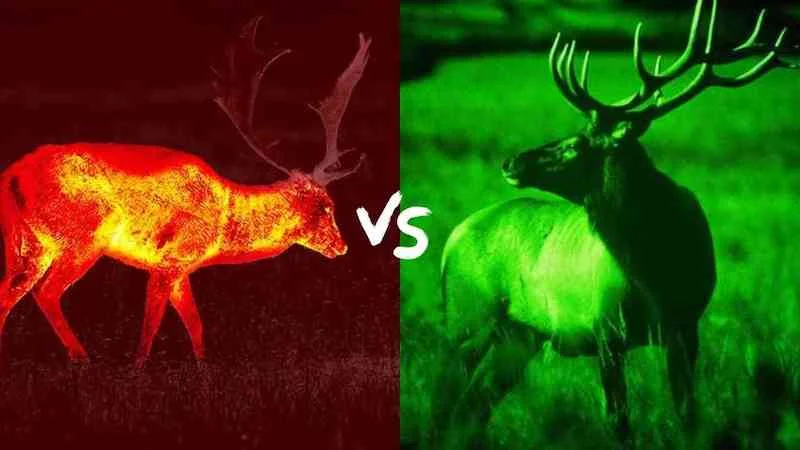
However, night vision scopes use a special lens to magnify light and provide an enhanced image of the area being viewed.
Night vision scopes can only be used during the night because they need to see light before they can magnify it.
Thermal scopes can be used in the day or at night because they detect heat from objects, not light.
Night vision scopes provide a clearer image than thermal scopes, but thermal scopes can be used during the day or at night.
If you are planning on using your thermal scope for surveillance or security purposes, then choose one that has a high resolution and sensitivity.
Here we have reviewed the top 5 best thermal scopes for you.
1. FLIR Systems Scout III-240 Thermal Imager

This is the next generation of FLIR’s line of compact thermal scopes. You will find the performance is enhanced with the 30Hz or 60Hz imaging.
The Scout III shows up the heat emanated from animals as well as humans, and you will find many applications for this, such as land management and legal hunting.
Included with the scope is a USB Power Adaptor/Charger, wrist strap, custom video-out cable, a USB cable, and a Quick Start guide.
You will notice that the images are crisp and clear on the 640 x 480 display screen. The scope powers up in just a few seconds, and is easy to use. No training is needed as it is very clearly displayed.
The scope is compact and rugged, both weather and water resistant, and has an extended battery life.
2. Armasight Predator 336 2-8×25 (60 Hz)

This thermal scope is the latest in Flir technology, with extended operation time that is available with an optional extended battery pack.
You will find this scope a very solid instrument, uncooled, and with long-wave infrared.
I tis intended for both day and night use so will detect your target through darkness as well as fog, smoke, and haze.
One advantage with predator thermal scopes is that they are very difficult to spot because they do not emit any visible light or RF energy.
The control functions are very easy to understand and to operate, as is the electronic menu. There is a video-in feature and external power access.
Weapon installation is remarkably easy, and the scope is very user-friendly, which means it gets one of the best thermal scope reviews.
3. ATN ThOR HD 384 Smart Thermal Riflescope

This scope is perfect for working at night because it detects heat energy instead of light, with the Image Performance 384 x 288 Sensor.
You will find that you are able to see perfectly clearly in total darkness.
The Ballistic Calculator allows you to work out the trajectory of the bullet to help you hit your target.
This means that by adjusting your Point of Impact, your shot placement is better.
You will be impressed with the high-resolution HD recording and photos, as well as the recoil activated video (RAV).
There is also wi-fi streaming, so you can record your hunt to review later.
Built out of highest quality materials, we think you will agree that this is one of the best thermal scopes on the market.
4. Pulsar Apex XQ38 2.2-8.8×38 Thermal Riflescope

The XQ offers a 2.1 x base magnification with 2x/3x/4x digital zoom. There are three different operation modes, and 3 zeroing distances.
The scope comes with a wireless remote control, video output power cable, 2 x CR123 batteries, a carrying case with cleaning cloth, easy-to-read user manual, and warranty card.
The stepped zooms, along with the continuous zoom feature make this one of the best thermal scopes for the money.
5. Firefield FF16001 NVRS 3x 42mm Gen 1

You will like this ergonomic design with built-in IR. The body is built from sturdy titanium.
This scope will ensure you can see and hit your target even in the darkest of nights.
The quick-detach mounting system makes it very easy to change optics or sights, while t
he 42mm lens means higher light gathering capabilities.
The scope comes with a powerful 3 x magnification.
You will notice right away that the scope is sturdy and rock-solid, even though it is lightweight.
There is a unique feature of a lens cover which flips up to protect it from harsh or adverse conditions.
We think that the high-quality image and resolution, along with the solid titanium body make this one of the best thermals scopes available.
How to Choose the Right Thermal Scope (Buying Guide)
How much do you want to spend?
Cost is a very important factor to consider when choosing a thermal scope and it is something that can affect your buying decision a lot.
The higher the quality of the thermal scope, the more expensive it is. However, it will not always be reflected in the price.
Thermal scopes range in price from $200 to $3000. The more you pay, the better the quality of the image and the longer the battery life.
The best type of thermal scope that can fit your budget is one that comes with an image intensifier and with the right magnification you can get an excellent image.
How much magnification do you need?
The magnification is how far away you can see an object. For example, a 2x magnification means that you can see objects twice as far away. Some thermal scopes have up to 25x magnification. The greater the magnification, the more expensive it will be.
How much resolution do you need?
Resolution determines how clear your picture will be. Higher resolution devices are more expensive because they provide a clearer image.
This is the number of pixels on the screen that represent one degree of temperature. Most thermal scopes have a maximum resolution of 1000 px but the actual resolution of the thermal scope is much lower. However, if you zoom in, you will be able to see very fine details.
Sensitivity This is the minimum temperature resolution that the thermal scope can detect. You can read more about this in the following article.
This is how the resolution and sensitivity compare in a thermal sense. The lower the numbers are the better the thermal resolution and sensitivity.
What temperature range do you need?
Thermal scopes usually detect temperatures between -20 degrees to 120 degrees Celsius. Some thermal scopes can detect temperatures as low as -50 degrees Celsius or as high as 300 degrees Celsius.
However, if you wish to use the thermal scope for higher temperatures, you should check the maximum temperature you can use the thermal scope for.
The red line on the thermal scope represents the hottest temperature you can see. The blue line represents the coolest temperature you can see.
While the range of temperatures is very useful for detection, it is not useful for accuracy. You cannot tell whether a temperature is within +/-5 degrees Celsius, for example.
What refresh rate do you need?
The refresh rate determines how often the image on the screen is updated. This is the number of times per second that the thermal scope refreshes.
A higher refresh rate provides a clearer image, but it also costs more money. This is especially useful if you are in a situation where the thermal scope may be constantly displayed on a screen.
A refresh rate of 5-10 Hz is normal, and anything above that is considered high. Refreshing anything more than 10-20 times per second is not recommended.
Because the device is always displaying the thermal scope, the computer will have to recalculate the temperature every time you refresh the display. This causes the device to run at a higher power level and increases the temperature.
How far away do you need to see?
Thermal scopes provide a longer detection range than night vision scopes. Thermal scopes can detect objects from 50 meters to 3000 meters away, whereas night vision scopes can only detect objects from 30 meters to about 700 meters away.
What reticle options do you need?

Reticles are crosshairs that allow you to aim your thermal scope at your target. Some reticle options include a red dot, a circle, or crosshairs.
A reticle is an important feature of your scope that allows you to aim your gun at your target. Without one, you would be shooting blind, which is never a good thing. Your reticle should have different options depending on what kind of weapon you plan on using.
A red dot option is the best option if you are either sniping or shooting long distances. The crosshairs are ideal if you are planning on shooting at a closer distance, but still from a range.
The circle is very useful if you are shooting long range from a prone position. The dot is the best option for shooting from an elevated position, such as a tree stand.
What size does it need to be?
Thermal scopes can be find as small or large as the user needs them to be. They can be made to fit on a pistol or rifle. They can also be made to fit on a helmet or headgear. The smaller the thermal scope, the less expensive it will be.
A thermal scope with a large crosshair will be easier to focus on distant targets, but a small thermal scope with a large crosshair will be easier to focus on near targets. The weight can also be adjusted to be as light as possible or as heavy as you need.
What color do you need?
Thermal scopes come monochromatic or grayscale in addition to a few color options and nine color variations.
You can choose from gray scale, green, red, yellow, black, white and blue. Although these colors don’t have any effect on the quality of the image, they may affect how you perceive the image.
Some of these colors are used to enhance the contrast on the thermal deformation while others are specifically designed to be camouflaged on a certain environment.
For example, if you are using it in a jungle environment the green color would blend in with the surroundings while the yellow one will stand out making it easier for you to detect objects.
How long does the battery need to last?
The battery life of a thermal scope determines how long you can use it before having to change the batteries. Longer battery life means that you don’t have to stop using your thermal scope as often.
If you are going to be using your thermal scope in a situation where you won’t have the ability to charge the batteries, then you should choose a thermal scope that has a long battery life.
How do you plan on using the thermal scope?
The best thermal scope for you depends on how you plan on using it. If you are planning on using your thermal scope for hunting, then you should choose one that has a red dot reticle and a high refresh rate.
Conclusion
Before buying your thermal scope, it is important to consider how and when you will be using it, as well as whether you need it attached to a rifle or not. Also consider the weight of the scope, certainly if you intend to carry it for extended periods of time.
You will find that all our thermal scope reviews offer you the best value for money, as well as the highest quality products on the market.

